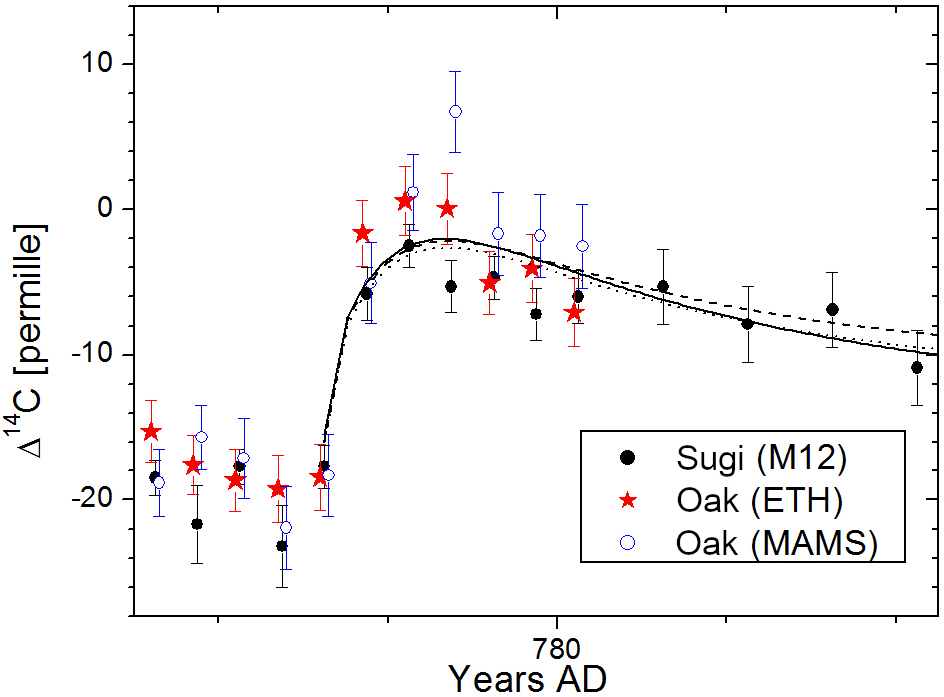There have been recent posts wondering if a black hole will consume the earth, or if the sun is going to explode in December. Some of us tried to dispel such ideas by various means, a few perhaps more effective than others.
But one of these notions caught my eye. It was posited within one of the threads and asked a question about a massive "solar flare" - one hitting the earth with apparently dire consequences. While this seems highly unlikely, some of these "proton events" have been known to cause transmutation of elements at the earth's surface by increased production rates of cosmogenic radionuclides- known as "ground level enhancements". One of these events is well established as occurring ca. 2600 B.P.* And another in 774–775 A.D**. And there have been a number of others recorded within the last 10,000 years or so. Reports I have read largely rely on C14 increases above background, since most other "newly" formed radionuclides, likely the most hazardous, would have decayed long ago.
Data for such events is scarce, as is long term knowledge of the sun's activity. Is it possible that an "extreme solar proton event", strong enough to cause transmutation of surface elements, represent a threat to life exposed to it? It is well known that proton events can cause severe problems and damage in communications, and result in mutations to people flying at high altitude (and in space). Is it even possible to know the extent of such extreme events resulting in deadly ground level enhancements? Evidence for such events like the ones referenced are apparently rare, but given enough time, the sun could produce another event, possibly one much more powerful. Would anyone care to address an upper limit to the magnitude of such an event, and could it cause significant harm to life on earth?
*

 www.pnas.org
www.pnas.org
** 774–775 A.D event

 en.wikipedia.org
en.wikipedia.org
But one of these notions caught my eye. It was posited within one of the threads and asked a question about a massive "solar flare" - one hitting the earth with apparently dire consequences. While this seems highly unlikely, some of these "proton events" have been known to cause transmutation of elements at the earth's surface by increased production rates of cosmogenic radionuclides- known as "ground level enhancements". One of these events is well established as occurring ca. 2600 B.P.* And another in 774–775 A.D**. And there have been a number of others recorded within the last 10,000 years or so. Reports I have read largely rely on C14 increases above background, since most other "newly" formed radionuclides, likely the most hazardous, would have decayed long ago.
Data for such events is scarce, as is long term knowledge of the sun's activity. Is it possible that an "extreme solar proton event", strong enough to cause transmutation of surface elements, represent a threat to life exposed to it? It is well known that proton events can cause severe problems and damage in communications, and result in mutations to people flying at high altitude (and in space). Is it even possible to know the extent of such extreme events resulting in deadly ground level enhancements? Evidence for such events like the ones referenced are apparently rare, but given enough time, the sun could produce another event, possibly one much more powerful. Would anyone care to address an upper limit to the magnitude of such an event, and could it cause significant harm to life on earth?
*

Multiradionuclide evidence for an extreme solar proton event around 2,610 B.P. (∼660 BC)
This study provides evidence of an enormous solar storm around 2,610 B.P. It is only the third such event reliably documented and is comparable with the strongest event detected at AD 774/775. The event of 2,610 years B.P. stands out because of its particular signature in the radionuclide data...
** 774–775 A.D event

774–775 carbon-14 spike - Wikipedia
 en.wikipedia.org
en.wikipedia.org
Last edited:


